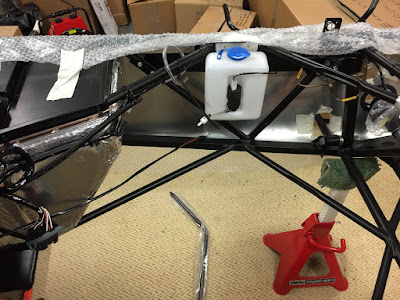Only had an afternoon, but got quite a lot done considering. The correct bolts for the Chassis cross-member have now arrived so the first task was to fit and torque those. However, whilst under the car we noticed that one of the wires has snapped off the reverse light
switch, no idea how that has happened. We also discovered that the set screws for the quick-release steering wheel were mushroom headed, not countersunk, (see below). However Derek is again very is kindly
sending us out another one and some countersunk screws.
Oops, wrong type of screws...
The next task was to fit the steering column, relatively simple task, starting at the bottom, with the universal joint, ensuring that the yoke was either vertical or horizontal 'to ensure linearity of response'.
Universal joint into steering rack,
Then, between the pedal box and the firewall is the joint for the upper steering column, this allows adjustment of the steering wheel distance from the dashboard using the grub screw and lock nut (see below). Initially we thought that the anodized piece you can see in the photo was the other way up, however we're pretty sure that this is the correct orientation.
Upper steering column clamp.
Next was to start fitting the exhaust; perhaps it would have been best to fit the exhaust headers BEFORE the steering rack, however it really wasn't that difficult to do with the lower column in place. The part numbers did not appear to correspond with the manual, however, it's pretty easy to work out, start with the rearmost and work forwards. Feeding it through the hole in the side of the body (reinforce the protection around the hole before you do this) and then twisting into place.
Exhaust headers, relatively simple to do, just a 3D puzzle really!
All fitted into place.
I have to say we are pretty impressed with the exhaust, it all fits together pretty darn well and with pretty good precision, fits nicely and squarely into the cut out in the body. About the only thing we had to do was to to open out slightly the ends of the clips on the springs so that they fit better on the collector and header pipes.
It was getting late at this point but we spent some time gathering the radiator parts together and mocking up how everything fits together. I have to say Andrew Bissell's blog post on the matter is going to be our reference for how to do it (Thanks Andrew).
Parts mocked up ready for next time.

















































